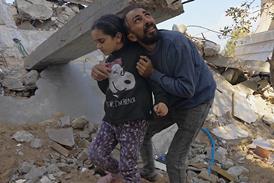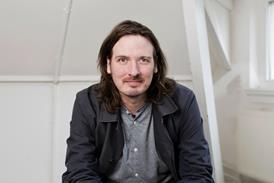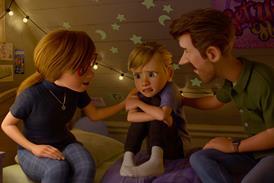Frank Sinatra sung that he wanted to be a part of it, and it is certainly true for the footloose producers who stream into the city that never sleeps.
Since New York's tax incentives were first introduced back in 2004, the city has played host to Sony's Spider-Man 3, Warner Bros' thriller The Brave One starring Jodie Foster, and Twentieth Century Fox's action adventure Jumper starring Hayden Christensen.
The city has also recently hosted Working Title and Focus Features' Burn After Reading directed by the Coen brothers, New Line Cinema's Sex And The City: The Movie, Jerry Bruckheimer Productions' Confessions Of A Shopaholic, Fox's The Day The Earth Stood Still and Columbia Pictures' Julie & Julia, starring Meryl Streep.
Producer Ted Hope, who has been making films in the city for 15 years, including The Ice Storm, Eternal Sunshine Of The Spotless Mind and The Savages, has witnessed the introduction by New York City mayor Michael Bloomberg of the 'Made in NY' film production tax scheme in 2004, which has helped entice these productions.
'There was a huge increase in production in the city after that,' says the co-founder of New York-based outfit This Is That Productions.
In fact, the tax scheme was judged so beneficial by producers that just two years after its introduction, it had already reached its $50m allocation and ploughed $1.5bn into the local economy.
Bloomberg has since signed into law a bill expanding New York City's 5% tax credit on below-the-line expenses for qualifying film and television productions.
What's more, last week it was revealed New York State plans to expand its existing tax incentive by two years to 2013 and increase credit to 30% from 10%.
Films and television productions that complete at least 75% of their stage work in New York City can therefore claim a 30% refundable tax credit from New York State, together with a 5% refundable tax credit from New York City. There is also an additional marketing credit for productions that complete 75% of their work in New York City.
New York tries to make shooting on its streets as comfortable as possible. The Mayor's Office of Film, Theater & Broadcasting issues free permits to productions, with access to public locations and street parking for essential production vehicles.
Projects shooting at an exterior location which require traffic control, or include a scene with prop firearms or actors in police uniforms, can request that the New York Police Department movie and TV unit be assigned to their location.
'It's not difficult to shoot in New York,' says Anthony Bregman, head of New York-based production outfit Likely Story, which is one of the producers of Charlie Kaufman's upcoming comedy drama Synecdoche, New York starring Philip Seymour Hoffman.
The production shot across the city, including in the Bronx and Brooklyn, at the end of last year. 'The government is very friendly. You get the police for free. You get access to parks and streets for free, and shooting on location is made to be as easy as possible.'
Of course, that does not necessarily stop the public and paparazzi interfering with shoots, as happened with Sex And The City: The Movie, which filmed on location last year.
The sight of the film's stars, especially Sarah Jessica Parker, proved traffic-stopping, breathlessly chronicled by bloggers and gossip writers desperate for an inside track on the plot.
'New York is a singular location that could never be duplicated - especially since we consider it the fifth character in the movie. It is an honour to film here - whenever possible,' says John Melfi, who produced Sex And The City: The Movie for New Line.
The downside for those wishing to shoot in the city is that it can prove very costly, as well as being busy and noisy. 'You don't have a lot of empty areas to shoot things,' says Bregman.
'I wouldn't shoot a period film here for example. But the cost of shooting in New York City is offset to a certain degree by the rebate.'
However, New York faces increased competition from other US states also offering rebates.
In fact, over the past few years, almost every individual US state has created some form of tax-based programme designed to boost the local economy with film-production dollars - money that might previously have been spent in Canada or internationally.
Producers and tax experts agree the schemes in Connecticut (which offers a 30% tax credit and is hosting Rebecca Miller's The Private Lives Of Pippa Lee), Louisiana (a 25% investor tax credit plus other smaller breaks), Massachusetts (20% on payroll and 25% on non-payroll expenses), New Mexico (a 25% tax refund) and South Carolina (20% rebate on payroll and 30% on other in-state expenses) are among the most valuable and workable. However, the revised New York incentive is set to provide producers with a 35% tax credit.
At press time, Michigan was set to sign legislation for a film-production incentive which is already being called the most enticing in the US: a 40% refundable or transferable tax credit for producing films in the state, with an added 2% for films produced in 'core' communities.
Tax credits also will be given for building production facilities in the state and for hiring and training Michigan workers in the film industry. The legislation will provide loans and allow film-makers to use state and, potentially, local property free of charge, including parks, roads, buildings and landmarks.
So can costly New York City stay competitive' 'People are shooting where the soft money is, such as Connecticut, Pennsylvania and Michigan,' agrees John Sloss, of New York-based Cinetic Media and Sloss Law Office.
'But it's rare that one of our projects is not shooting locally. New York City is as busy as ever. It might not be as competitive as some others, which are super aggressive, but it's still more competitive than LA.'
Hope agrees incentives in other states have been luring producers - Connecticut declares that it has attracted $400m in film expenditure and 66 features, while Louisiana has seen its annual production rise from $7m to almost $350m - but he points out that his colleagues who have shot in the other states have discovered New York's tax scheme is still one of the most flexible.
'A lot of productions have been moving to Connecticut, for example, but when I speak to out-of-state producers, they say it's not as beneficial as it first seems,' he says, suggesting producers shooting outside New York face more restrictions on what is applicable for a state tax cut, unlike the more flexible New York.
Bregman says New York has lost none of its shine. 'It's never been busier or harder to find crews. Being able to shoot here is hard because so many movies are shooting here.'
Five or six years ago, Canada was a financial thorn in the side of New York, with a number of productions moving to cheaper Toronto or Vancouver where they could recreate New York City landscapes at cut-rate prices. But since then, says Bregman, tax credits and a falling US dollar have meant it is no longer any cheaper to shoot in Canada than it is in New York.
In fact, he points out New York is so cost-effective the city has hosted films that are not even set there. In addition to shooting New York City for Synecdoche, This Is That has also shot New York for Columbus, Ohio, for The Weinstein Company's The Ex, a comedy starring Zach Braff which filmed in the borough of Staten Island last year.
Local talent
Another major lure for New York is its wealth of home-based talent, both in front of and behind the camera.
'If you start moving actors around (to a different state), you have to plan around and it can eat into your budget,' says Anne Carey, Hope's partner at This Is That. 'We've taken jobs out-of-state, but New York City has such incredible talent. If you're an under-budgeted production and you want to keep your crew as small as possible, New York works well. Using crews here is helpful, as through them you can get deals with equipment. You can't compete with people here on how to get a bargain.'
Bregman adds: 'New York doesn't have to beat other people's rebates to stay competitive. Movies shooting in New York will continue to shoot here as it is more cost-effective.'
And US and international producers are not just coming for the locations. The studios have also been getting in on the action, with the Kaufman Astoria benefiting the most. Home to six column-free stages, including a mammoth 26,000sq ft stage - the largest east of Hollywood - the studio played host in 2006 to Spider-Man 3 and The Bourne Ultimatum. In 2007, Brooklyn's Steiner Studios, which sits on 15 acres and has five sound stages, housed JP Schaefer's Chapter 27, about John Lennon's killer Mark Chapman, and Michael McCullers' Baby Mama with Tina Fey, last year.
Despite no longer accommodating the TV shoots of The Sopranos and Sex And The City, Silvercup Studios in Long Island City, Queens, has 13 shooting stages on its main lot ranging in size from 3,000-18,000sq ft, five 16,000sq ft studios on its East Lot, with a new six-acre expansion including eight soundstages. It has also hosted film shoots such as Birth, Music And Lyrics and El Cantante.
As Bregman insists: 'New York is more competitive than it has ever been.'




















No comments yet